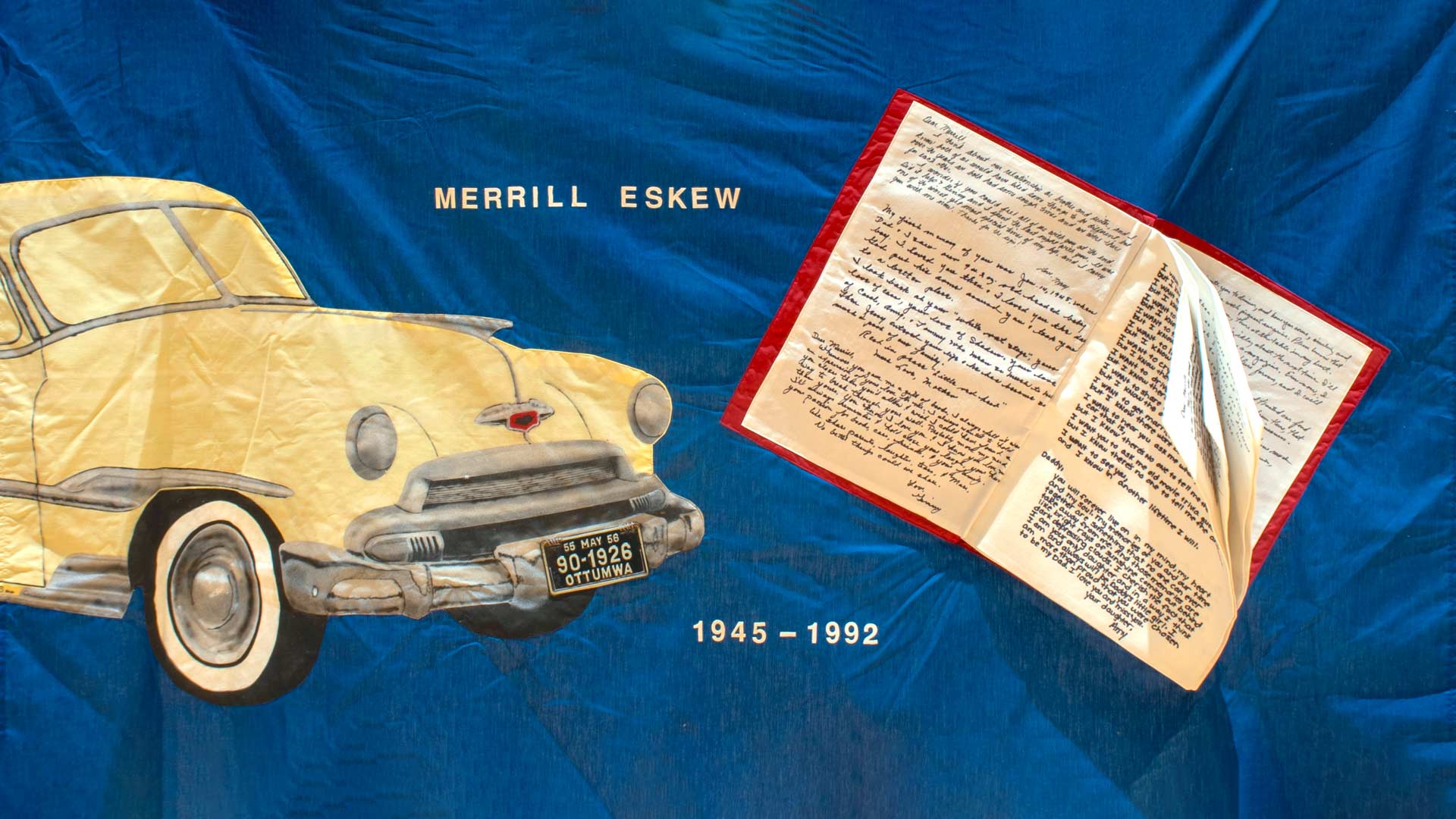Sewn In Memory: AIDS Quilt Panels from Central Illinois

General Overview
The AIDS Memorial Quilt began as a grassroots effort in 1985, by the activist Cleve Jones and others in his circle who wanted to document the lives of friends who had died of AIDS, and who they feared history would neglect. Their project was called the NAMES Project AIDS Memorial Quilt. On October 11, 1987, the quilt was displayed for the first time on the National Mall in Washington, DC, during the National March on Washington for Lesbian and Gay Rights. It was larger than a football field and included 1,920 panels. By 1988, there were 6,000 panels. Today, the National AIDS Memorial is the keeper of the more than 50,000 quilt panels, commemorating 105,000 individuals who died of AIDS. In all, more than 700,000 lives in the US have been lost to AIDS and more than 1.1 million people live with HIV.
Sewn in Memory: AIDS Quilt Panels from Central Illinois features over a dozen panels originally made in the 1980s and early 1990s for the AIDS Memorial Quilt by residents of Central Illinois. Each of the panels in the exhibit commemorates a person who died of AIDS, or of an AIDS-related ailment.
Sewn in Memory is a community-curated exhibit, created with Spurlock Museum collaborators, the Greater Community AIDS Project of East Central Illinois (GCAP), which holds the panels and assisted in exhibit research and creation; History Harvest, a course here at UIUC, which seeks to gather historical stories and documents from local communities; and Illinois Public Media (WILL), which is working on documentary films about the panels with UIUC Journalism students.
We commemorated 40 years since the first cases of what came to be known as HIV/AIDS first appeared. HIV/AIDS hit the large cities first and came to Central Illinois in the 1980s. In ‘81, when my dear friend Steve Gallagher tested positive, my life turned upside down. I watched Steve and other dear friends, like Merrill Eskew, get diagnosed, become extremely ill, and suffer through agonizing, ugly deaths. I don’t want their lives, their names, or their deaths to be forgotten. This is why I’m thrilled to share their stories and bring to light the stories of victims who I didn’t know as well. The Spurlock exhibit is bringing the community’s attention to this period of our history, which frankly isn’t over. We have a vaccine for COVID, after such a short time, but after 40 years we still don’t have a vaccine for HIV/AIDS.
Jerry Carden, Founding Member, Greater Community AIDS Project
People need recognized spaces to mourn, to remember, to commemorate, to be inspired by the work that has been done, and to celebrate the positive changes that have been made. We hope the exhibit can offer ways for people to come together around these timely needs. We’re also thrilled to highlight the work of two groups of University students: the History Harvest and Journalism classes who have worked directly with local communities and bring their voices to museum visitors.
Beth Watkins, Education & Publications Coordinator and one of the exhibit organizers, Spurlock Museum
About the AIDS Memorial Quilt
The AIDS Memorial Quilt is a living memorial to a generation lost to AIDS. Today, it comprises nearly 50,000 panels dedicated to 105,000 individuals who lost their lives to AIDS. The idea for the quilt was conceived in 1985 by San Francisco gay rights activist Cleve Jones and other activists in his circle who wanted to document the lives of friends they feared history would neglect. Their project, called the NAMES Project AIDS Memorial Quilt, was born.
People from across the country immediately began sending quilts to the NAMES Project workshop. On October 11, 1987, the quilt was displayed for the first time on the National Mall in Washington, DC, during the National March on Washington for Lesbian and Gay Rights. It was larger than a football field and included 1,920 panels. The quilt toured the country in 1988, adding 6,000 panels. In 1989, the quilt traveled the world and inspired similar commemorative projects in 20 countries. That same year, Cleve Jones, Mike Smith, and the NAMES Project Foundation were nominated for the Nobel Peace Prize.
In 2019, the National AIDS Memorial became permanent caretaker and steward of the Quilt. Today, the quilt comprises nearly 50,000 panels, commemorating 105,000 individuals. Forty years into the AIDS pandemic, more than 700,000 lives in the US have been lost to AIDS and more than 1.1 million people live with HIV.
For educational resources and an online exhibit of the entire quilt, you can visit the National AIDS Memorial website.

In Memory of Stephen Gallagher 1948–1991, by Jerry Carden and Steve Otto et al., 1993. Property of GCAP, Urbana, IL.

In Memory of Mike Hyman, by Stephen Gallagher, circa 1993. Property of GCAP, Urbana, IL.

In Memory of Merrill Eskew, by Eskew’s Family, circa 1988–1996. Property of GCAP, Urbana, IL.

In Memory of Dr. Ronald Steinhoff, Artist Unknown, circa 1988–1996. Property of GCAP, Urbana, IL.

In Memory of Paco Arbogast, Artist Unknown, circa 1988–1996. Property of GCAP, Urbana, IL.